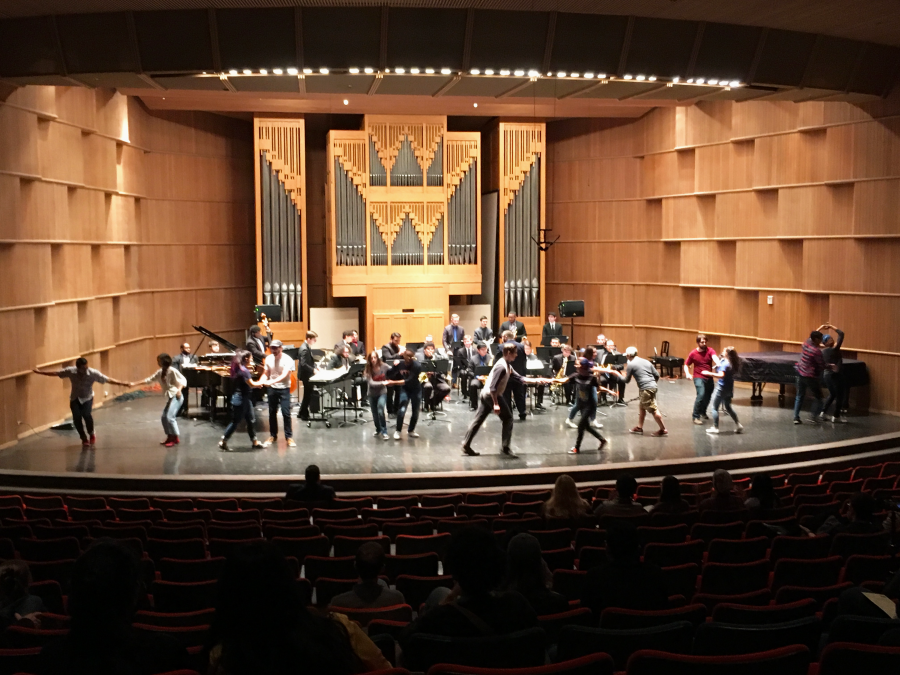The Lindy Hop, Charleston and Balboa are some of the most recognizable forms of swing dancing derived from Latinx and African American cultures and popularized during the 1920s. These dances incorporate rapid, vigorous gyration of the hands and feet as dancers fly across the dance floor. However, what is a dance without any music? Jazz, big-band and swing music – also derived from African American culture – came from the Southern United States and New Orleans, Louisiana. Thumping rhythms and vivacious horns carry beats that drive dancers into pulsating convulsions.
The UTSA Main Campus Recital Hall came alive on Feb. 21, as the UTSA Jazz Ensemble performed their “Swing into Spring” concert. From historical hits like William ‘Count’ Basie’s “Jumpin’ at the Woodside” to sultry Sinatra songs like “The Way You Look Tonight,” the UTSA Jazz ensemble electrified the audience with an hour-long spectacle. Later, the UTSA Swing Society even danced along on stage during many of the numbers, engaging other audience members to hop up and join in the fun.
The show began with assistant director Michael Steiner walking to the front of the ensemble as director Dr. Adrian Ruiz found a seat in the front row. Steiner took a deep breath, adjusted his sheet music and casually pointed over to the drums as Ezek Zamorano began a punchy beat on the floor tom and hi-hat. Immediately, audience members were bobbing their heads and tapping their thighs – a sight that would continue throughout the entire number and show as the rest of the ensemble came in for Luis Prima’s “Sing Sing Sing.” Following the second piece, Benny Goodman’s “Don’t Be That Way,” Steiner introduced Ruiz to the stage.
“The dance floor is open; please don’t be shy and come cut a rug up here with us,” Ruiz said, before bringing out singer Roselyn Rios for Frank Sinatra’s “The Lady is a Tramp.”
After introducing the rhythm section, numerous members of the UTSA Swing Society entered the hall and crowded the foot of the stage in anticipation for the next tune. Smiles spread across every face in the recital hall as the dancers strolled and skipped onto stage while Steiner conducted the band once again. Ruiz then introduced the second guest vocalist for the evening, Alex Gutierrez Aguirre, to accompany the group’s rendition of Morgan Lewis’ “How High the Moon.”
As the night continued, the horns crooned over the enamoring reed section while the rhythms were reminiscent of thumping hearts, all replicating and personifying the interactions apparent between the dancers and audience members on stage. Guest conductor, Roland Sandoval, later took the stage for ‘Count’ Basie’s “Jumpin’ on the Woodside” and “One O’ Clock Jump” to fervent fanfare from the dancers.
The jubilation carried on during pieces like “Leap Frog” and familiar favorite “Little Brown Jug.” Steiner and Ruiz recognized the reed, trombone and trumpet sections respectively before Ruiz celebrated and thanked the UTSA Swing Society once again for coming out.
“It’s really exhilarating to feel the energy that the dancers bring. It only fuels the performance…and this is dancing music; if it weren’t for the dancers, this [performance] wouldn’t make any sense,” Ruiz said.
The night’s performance closed with Joe Garland’s “In the Mood,” a piece Ruiz described as, “the national anthem of all swing music.” He also prefaced the closer with a close-to-home fact about the piece’s arranger, Eddie Durham; a musician from San Marcos, Texas, who was also the first to “electrify the jazz guitar,” Ruiz said.
“Swing into Spring” was a celebration of all the components of swing. The combination of the UTSA Jazz ensemble and Swing Society showcased the magic and power of two organizations coming together for one unforgettable night.
For more information about the respective groups, visit music.utsa.edu and utsaswingdance.weebly.com
Categories:
Swing into spring
February 26, 2019
UTSA Swing Society dancers gyrate to the
boisterous sounds provided by the UTSA Jazz Ensemble. Kirkland Luther/The Paisano







